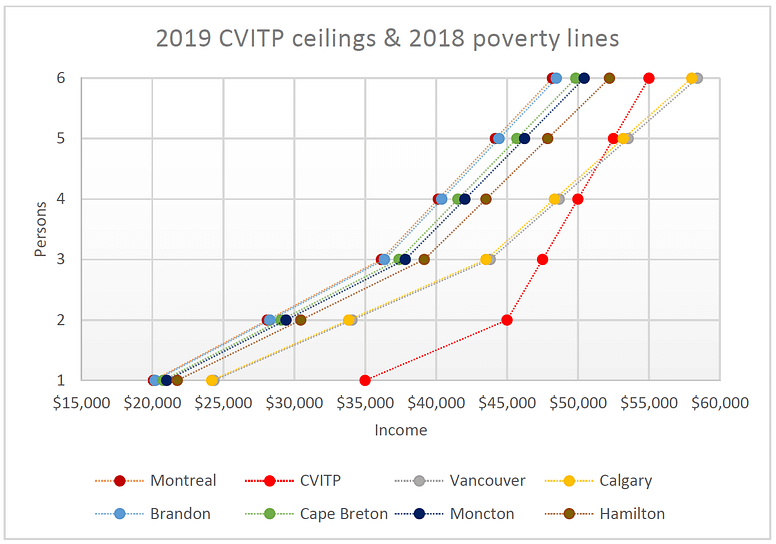November 15, 2020
Introduction
CVITP clinics demand a fair amount of human and financial resources to set up and run. Given that resources are usually in short supply, this frequently means that the client demand for this free service often exceeds the time slots available for appointments. One way of reducing the excess demand is to limit the number of people eligible to receive this service.
The chief way that the CRA suggests this be done is using income ceilings. This seems logical enough as one objective of the CVITP is to provide a free service to low-income Canadians who could not otherwise afford to pay for it. Thus, for the 2019 tax season, the CRA suggested that the following ceilings be used:
| family size | total family income is under… |
|---|---|
| 1 person | $35,000 |
| 2 persons | $45,000 |
| 3 persons | $47,500 |
| 4 persons | $50,000 |
| 5 persons | $52,500 |
| More than 5 persons | $52,500 plus $2,500 for each additional person |
However, the CRA indicates that host organizations can apply different income ceilings if they chose. This article looks at a simple method host organizations can use to define income ceilings that might better match the needs within their community and suggests that this could be used in situations where demand for CVITP services outstrips the supply.
Comparing the CVITP income ceilings and the official poverty line(s)
How close are the CVITP income ceilings to the official poverty line? In our article on Canada’s official poverty line, we point out that there are 53 different poverty lines across Canada and that each of these varies according to the size of the family. This reflects the diverse costs of goods and services to be found in the different communities and the greater costs associated with supporting a larger family.
Stated another way, two persons with the same income but residing in two different regions could have different standards of living; one person is living below and the other above the poverty lines established for their respective regions. Similarly, two families residing in the same region and with the same income but different family sizes could have different standards of living; one family is living below and the other above the poverty line established for their region.
This leads to the question: Just how well does the CRA set of suggested CVITP income ceilings align with the 53 different poverty lines?
Let’s take a look at a sample of the poverty lines of seven regions from the 53 different poverty lines and compare them with the CRA’s 2019 CVITP income ceilings.

The most recent figures available for the 53 poverty lines are for 2018; the 2019 figures for the poverty lines would be slightly higher, taking into account the modest inflation in costs since 2018. Note that the CVITP income ceilings are represented by the red line.
One can see three notable differences (which also apply to the other regions in Canada that have not been charted here):
For all of the regions, the CVITP income ceilings significantly exceed the poverty line values where the family size is small (1-3 persons). This suggests that by using the CVITP income ceilings for smaller family size, host organizations will be serving some individuals and families who have lower incomes but who will not be considered poor.
For many regions, the CVITP income ceilings exceed their poverty lines regardless of family size. This suggests that by using the CVITP income ceilings in these regions, host organizations will be serving many individuals and families who have lower incomes but will not be considered poor.
For urban centres where the cost of living is higher and therefore the poverty lines are higher, the CVITP income ceilings fall below the poverty lines when the families are composed of 5 or more persons. This suggests that by using the CVITP income ceilings in these urban centres, host organizations may be excluding some large families that are considered poor.
What are the implications for CVITP host organizations?
Everywhere in Canada, with the exception of the large urban centres, the income ceilings in the CVITP guidelines are above the official poverty line.
As this is a free service being offered to low-income individuals, the income ceilings in the CVITP guidelines should be aligned more closely with the official poverty lines. In those regions where host organizations are easily able to meet the demand for free CVITP services, there is no concern.

But in those regions where host organizations are unable to meet the demand and must ration CVITP services, host organizations may wish to consider being less generous with the income ceilings they use to define individuals’ and families’ eligibility for their CVITP services.
Looking at the 2019 CVITP income ceilings, one can see that there is a large difference between the poverty lines and the CVITP figures for individuals ($35,000) and couples ($45,000) in particular. For the 2019 tax season, host organizations with limited capacity to serve their clients could have reduced their own income ceilings to $30,000 for individuals and $40,000 for couples.*
We’ll revisit this when the CRA produces its suggested income ceilings for the 2020 tax season and, if we feel it is warranted, offer some revisions to our estimates.
*To keep the article short and readable, we have skipped over a technical issue. You can read more about it here.
